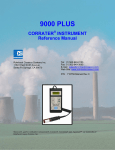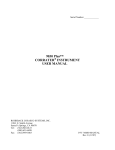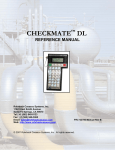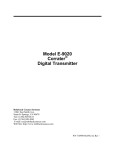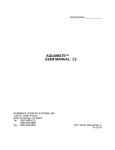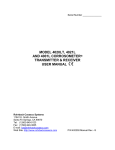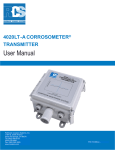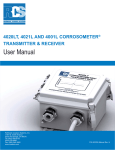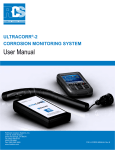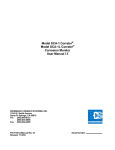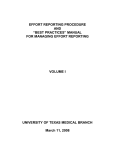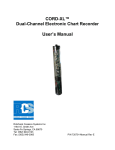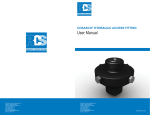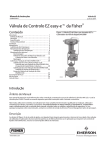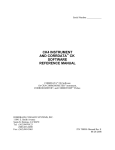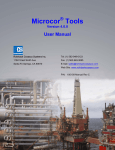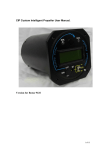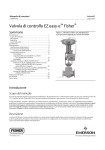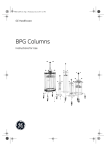Download Serial Number - Rohrback Cosasco Systems
Transcript
Serial Number CorrDATSJ SYSTEM USER MANUAL Corrosion and Deposit Monitoring System ROHRBACK COSASCO SYSTEMS, INC. 11841 E. Smith Avenue Santa Fe Springs, CA 90670 Tel: (562) 949-0123 (800) 635-6898 Fax: (562) 949-3065 P/N 720000-Manual Rev. C 02/2003 8 1991 - 95 Rohrback Cosasco Systems, Inc. All rights reserved. CORROSOMETER, CORRATER, CORROTEMP, are registered trademarks and CorrDATS is a trademark of Rohrback Cosasco Systems, Inc. DATS II is a trademark of Bridger Scientific Inc. No part of this manual may be reproduced or transmitted in any form or by any means, electronic or mechanical, including photocopying and recording, for any purpose, without the express written permission of Rohrback Cosasco Systems, Inc. Contents Chapter 1 Introduction.......................................................... 1 Chapter 2 Specifications ....................................................... 5 Chapter 3 System Installation ................................................ 7 System Physical Layout ...................................................................... 7 Connection of Heated CORRATER Electrodes .......................................... 7 Connecting the Non-Heated CORRATER Probe ........................................ 8 Connecting the 9030 Plus Output to the CorrDATS Controller....................... 8 Modem Communications Setup ............................................................. 9 Using CORROSOMETER Transmitters or Other 2 Wire Transmitters on Auxiliary Inputs.................................. 9 Chapter 4 System Operation................................................ 13 9030 Plus Settings for CorrDATS System Operation ..................................13 Deposit Monitoring Settings................................................................15 Chapter 5 Maintenance....................................................... 17 Figures and Drawings Figure Page 1.1 CorrDATS System ............................................................................ 1 1.2 System Configuration Options .............................................................. 2 3.1 Auxiliary Wiring for 9030 Plus............................................................. 9 3.2 Auxiliary Wiring for 2 Wire Transmitters Bypassing Auxiliary Input Connector .............................................................11 3.3 Auxiliary Wiring for 2 Wire Transmitters Via Auxiliary Input Connector .............................................................12 1 Chapter 1 Introduction Figure 1.1 CorrDATS System (excludes PC) The CorrDATS system provides a comprehensive data logging of corrosion, fouling and deposit monitoring. The data may be transferred directly to a PC, or over a modem link, for analysis. A particular feature of this system is the ability to monitor corrosion rate on the heat transfer surface, where metal temperatures are higher than the bulk water temperature. The increased temperature of the heat transfer surface can produce a significant increase in corrosion rates which need to be monitored. Rohrback Cosasco Systems and Bridger Scientific have collaborated to produce the new Rohrback Cosasco Systems CorrDATS integrated corrosion and deposit monitoring system. 2 CorrDATS System Manual In the actual field environment of water treatment, it is necessary to maintain the proper balance between low pH (more acidic) which increases corrosion, and high pH (more alkaline) which increases scaling tendency. Consequently, to achieve this balance, the operator must control pH, conductivity, corrosion, scaling and deposition. The CorrDATS unit was developed to specifically blend comprehensive, sophisticated yet field-proven technologies into an economical package. ] Figure 1.2 Flow Tube Arrangement The heat exchanger flow tube of the system is matched to the alloy of the plant heat exchanger to be monitored in the field. The flow through the tube is programmed and controlled to represent the most critical plant condition, usually the lowest flow velocity. The heated surfaces are programmed and controlled to represent the most critical heat transfer conditions, normally the highest heat flux, and connected to the highest water temperature from the plant heat exchanger outlet. This sets up the system for scale and deposit monitoring. All of the parameters necessary to perform heat transfer analysis are monitored and recorded. As deposits (scaling, microbial slime, sediments) accumulate, the tube surface becomes thermally insulated and the change in Heat Transfer Resistance (HTR) is electronically recorded. Changes in HTR due to corrosion and corrosion products may also be detected. In many systems, the heat exchanger tubing is a copper- based alloy and the rest of the system is carbon steel. Separate elements of the corrosion inhibition must be simultaneously regulated to prevent corrosion of both of these alloys. In addition, the corrosion rate on the heated exchanger tube material can change with temperature. The CorrDATS system is unique because: Chapter 1 Introduction 3 1. It provides CORRATER measurements from electrodes which are made from the same material as the heat exchanger, and; 2. The electrodes are under the same heat flux conditions as the deposit monitoring section of the system. The new 9030 Plus corrosion monitoring electronics are used in the CorrDATS system, for increased flexibility (see separate data sheet for more details). The 9030 Plus unit monitors multiple parameters, including: corrosion rate and pitting tendency from two CORRATER probes; pH from an optional pH probe; conductivity from an optional conductivity probe (an alternative to a second CORRATER probe); or approximate conductivity from a CORRATER7 probe. Figure 1.3 System Diagram Any four of the measured parameters from the 9030 Plus unit are data logged by the main control unit. The main control unit will store up to 124 records, and the cycle time of each record may be set from 0.05 to 99+ hours. PC Software is included with the system for uploading of the accumulated data. Data files are in ASCII format, (*.prn files) for importing into standard spreadsheet programs. In addition to this systems overview manual also included are the individual manuals on the basic 9030 Plus Unit and the DATS II unit. 4 CorrDATS System Manual 5 Chapter 2 Specifications Operational ! Maximum Heat Flux: 50,000 Btu/hr. ft2 ! Maximum Fluid Temp: +200°Deg F ! Maximum Fluid Pressure: 50 psi ! Flow Velocity Range: 1-10 ft/sec ! Reynolds No: 10,000 - 100,000 ! Tube Size: 7/8" dia. ! Tube Alloy: Any commercially available ! Enclosures: Plastic Sealed enclosures, Stainless steel/Aluminum heat exchanger case ! Corrosion Rate: 0 - 1000 mpy ! Imbalance (Pitting Index): 0 - 1000 pitting units ! Operating Range: Conductivity (!mhos/cm) divided by corrosion rate (mpy) > 4 ! 9030 Plus Data Logged Parameters: Max 4 ! 9030 Plus Inputs: 2 Channel Corrosion Rate, 2 Channel Imbalance, 2 Channel Temperature, 2 Channel approx. Conductivity (from CORRATER), 1 Channel Conductivity (with optional Conductivity probe, in place of 1 CORRATER Channel) ! Number of Stored Readings: 124 6 CorrDATS System Manual Mechanical ! Equipment enclosures excluding 9030 Plus unit are unrated moisture and splash proof resistant ! 9030 Plus unit is NEMA 4X rated ! Data logger/Control Unit 18" (460 mm) L X 16" (410 mm) W X 9" (230 mm) D ! Heat Exchanger 36" (1070 mm) L X 12" (300 mm) W X 9" (230mm) D ! Flow Controller 18" (460 mm) L X 16" (410 mm) W X 9" (230 mm) D ! 9030 Plus Unit 7.5" (190 mm) L X 7' (178 mm) W X 4.5" (115 mm) D Electrical ! Separate systems require for 115 VAC and 240 AC ! 115 VAC System 15 Amp 50/60 Hertz (requires ground fault interrupt circuit) ! 240 VAC System 7.5 Amp 50/60 Hertz (requires ground fault interrupt circuit) Environmental ! Temperature rating: 32 - 100°F (0 - 38C) ! Humidity: 0 - 90% RH ! Usage: Protected from Weather PC Requirements ! IBM PC or compatible ! MS DOS 3.3 or higher ! 2400 Baud modem for remote communications 7 Chapter 3 System Installation System Physical Layout The piping arrangement of the Heat Exchanger, the Flow Controller, and the separate CORRATER probe are important, to permit correct operation and access for the cleaning of the Heat Exchanger tube when required. On the flow inlet to the system, the input piping to the Heat Exchanger should be made with a union, and a Swagelok type coupling onto the Heat Exchanger tube. WARNING! The Swagelok type coupling should be through bored for attachment to the tube, but the ferrules MUST be NYLON or TEFLON to prevent damaging the tube. On the outlet to the Heat Exchanger another similar Swagelok type fitting and union should be used to connect to a Tee in which the unheated CORRATER probe is inserted (see 9030 Plus manual fig 3.4). After this Tee fitting another union is desirable. These unions permit the easy removal of the items adjacent to the Heat exchanger that permit easy access to clean the tube in the Heat exchanger when required. A 7/8" nylon tube cleaning brush on a 36" extension is ideal for cleaning the tube. Connection of Heated CORRATER Electrodes The heated CORRATER electrodes in the heat exchanger have a cable connection already made at the Heat Exchanger end. This cable is the middle cable of the three coming out of the exchanger. The free end of this cable has leads ready for connection to the probe 1 input of the 9030 Plus unit. Keep this cable separated from the power cable to the Heat Exchanger. The cable should pass through the cable gland on the 9030 Plus unit. Be careful that the connections are exactly as shown in figure 3.2 of the 9030 Plus Manual and similar but rotated 180 degrees from the cable on probe 2. A B C D E - Red White Black of Red/Black pair Black of Black/Green pair Black of Black/White pair 8 CorrDATS System Manual F G - Green Grey (Cable Screen) Connecting the Non-Heated CORRATER Probe The second probe, commonly with carbon steel electrodes is connected to the 9030 Plus unit with the second probe cable already installed on the 9030 Plus unit. Care should be taken when installing the probe into the Tee fitting to ensure the electrodes are in the flow, but that the probe body does not obstruct the flow. Connecting the 9030 Plus Output to the CorrDATS Controller Connect the analog output of the 9030 Plus unit (fitted with the plastic connector) to the Auxiliary Input of the CorrDATS controller and data logger. The connections of the 9030 Plus Channels 1 to 4 are pre-made to the auxiliary inputs 1 to 4 respectively of the Controller. The wiring connections to the 9030 Plus unit are as follows: NOTE: Loop 1 is on the right and Loop 5 is on the left. Loop 1+ Loop 1B Loop 2+ Loop 2B Loop 3+ Loop 3B Loop 4+ Loop 4B Loop 5+ Loop 5B Red Black of Red/Black pair White Black of White/Black pair Blue Black of Black/Blue pair Green Black of Green/Black pair not connected not connected Chapter 3 Installation Figure 3.1 Auxiliary Wiring for 9030 Plus (Self powered 4-20 mA loops) WARNING! Where an other transmitter, such as the model 4020LT CORROSOMETER Transmitter, is used in place of the 9030 Plus outputs, the corresponding outputs from the 9030 Plus unit must be disconnected (see section on using CORROSOMETER Transmitter or other 2 wire transmitters on auxiliary outputs). 9 10 CorrDATS System Manual Modem Communications Setup A relatively simple communication setup is used between the CorrDATS and the PC, without any form of error connection protocol. The modem at the PC needs to have its default stored profile set for no error correction. This normally means setting the &Q register to 0 (default is typically 5 for full error correction options). Modems do vary in their commands, and if neccessary reference should be made to the manual, RCS can assist if required. Setting up the modem to the default string requires a communication program such as PROCOMM. To setup the &Q=0 for startup, first, with a program such as PROCOMM, set up the modem being used. Type A7 and enter; the modem should respond with OK. Type AT&Q0. This will normally set the &Q register to 0. Type AT&W0. This will normally set the default profile with &Q=0 for all future startups. The DATS program should then be run normally. Using CORROSOMETER Transmitters or Other 2 Wire Transmitters on CorrDATS unit The auxiliary inputs on the CorrDATS controller unit may be from any 4-20mA inputs. If CORROSOMETER transmitters or other 2 wire transmitters (such as for pressure drop tube) are used, then the following wiring changes will need to be made inside the controller unit. This additional wiring may already have been done if the system was supplied that way. If for example one CORROSOMETER transmitter is fitted, the following is the wiring diagram. This makes use of an internal 24VDC supply to power the transmitter. WARNING! If the transmitters are set up as AUX 1 and AUX 2 on the CorrDATS controller, then loop 1 and loop 2 connections must be removed from the 9030 Plus output terminal block and the connections insulated from each other. Chapter 3 Installation Figure 3.2 Wiring 2 Wire Transmitters Bypassing Auxiliary Input Connector 11 12 CorrDATS System Manual Figure 3.3 Wiring 2 Wire Transmitters Through Auxiliary Input Connector 13 Chapter 4 System Operation 9030 Plus Settings for CorrDATS System Operation The settings on the 9030 Plus unit for Probe 1, which is the heated electrode set are slightly different from a standard CORRATER probe because the electrode area is three times larger than the standard CORRATER electrodes. Standard electrodes are 5 cm 2 each, whereas the heated electrodes on a standard f@ diameter heat exchanger flow tube are 15 cm2 each. To compensate for this the probe alloy multiplier in table 5-1 of the 9030 Plus Manual should be divided by three, for example: 90/10 Copper/Nickel would normally use a multiplier of 1.8 on standard CORRATER electrodes, such as on the unheated probe, but would be set at 0.6 for the heated electrodes. The probe type for the heated electrodes(probe 1) should be set to A2 Electrode@. The Probe setting for the unheated probe (probe 2) should be set to A2 Electrode@ unless a CORROTEMP CORRATER probe has been ordered. This latter probe includes a 100 ohm RTD temperature sensor. The Multiplier to be used for the heated electrodes in the flow tube are listed below according to the flow tube size. The standard size is f@ diameter but other sized are used from time to time according to material availability. The multiplier is computed as an inverse factor of the surface area of the electrode surface. Alloy multiplier to be used is: = M x Ao A1 Where M = the standard CORRATER probe Multiplier A0 = the area of the standard CORRATER probe electrode = 5 cm2 A1 = the internal surface area of the heated electrode in cm 2 (15 cm2 on f@ tube) For the standard f@ diameter heated flow tube: Alloy multiplier to use = M0x 5 cm 2 = M0 2 15 cm 3 14 CorrDATS System Manual WARNING! Make sure that the multiplier for the heated tube is not used for the standard unheated CORRATER probe. This factor directly scales the indicated corrosion rate. The following is a list of multipliers for commonly used heat exchanger alloys and tube sizes. For any other sizes the values may be calculated as shown above using the internal surface area of the tube electrodes (the length of each tube electrode = 1.00"). UNS Code Material Standard CORRATER Probe Multiplier f@ x 0.065" Tube Multiplier (x 0.33) 1” x 0.083” Tube Multiplier (x 0.295) K03005 Pipe Grade Carbon Steel 1.00 0.33 0.30 A91100 Aluminum 1100-0 0.94 0.31 0.28 A92024 Aluminum 2024 0.88 0.29 0.26 C11000 Copper 110 ETP Comm. Pure 2.00 0.67 0.59 C44300 CAD 443 Arsenical Admiralty 1.67 0.56 0.49 C44500 CDA 445 Phosphorized Adm. 1.68 0.56 0.50 C64200 CDA 642 A1 Silicon Bronze 1.48 0.49 0.44 C68700 CDA 687 Alum. Brass Arsenical 1.62 0.54 0.48 C70610 CDA 706 90/10 Copper/Nickel 1.80 0.60 0.53 C71500 CDA 715 70/30 Copper/Nickel 1.50 0.50 0.44 G41300 AISI 4130 Alloy Steel 1.00 0.33 0.30 N04400 Monel 400 Nickel 1.13 0.38 0.33 N05500 Monel K-500 Nickel 1.04 0.35 0.30 N06022 Hastelloy C22 0.85 0.28 0.25 N06600 Inconel 600 Nickel 0.95 0.32 0.28 N08020 Carpenter 20 CB3 SST 0.98 0.33 0.29 N08800 Incolloy 800 0.89 0.30 0.26 N08825 Incolloy 825 0.88 0.29 0.26 N10276 Hastelloy C276 0.86 0.29 0.25 R50400 ASTM B-348 Grades 2-4 Titanium 0.75 0.25 0.22 S30400 AISI 304 Stainless Steel 0.89 0.30 0.26 S31600 AISI 316 Stainless Steel 0.90 0.30 0.27 S31603 AISI 316L Stainless Steel 0.90 0.30 0.27 S31803 Duplex Stainless 2505 0.89 0.30 0.27 S32750 Duplex Stainless 2507 0.88 0.30 0.26 Chapter 4 System Operation 15 Deposit Monitoring Settings In general, for a plant application, the CorrDATS deposit monitoring section of the system is programmed to represent a section of the heat exchanger, where the worst conditions are represented. Alternatively the system may be programmed for some separate test and evaluation purposes. Calculation and setting of the required heat flux and flow rate is given is the DATS II manual. Some general principles can give guidance in these settings, to make the measurements representative. 1. The design or calculated heat flux for the plant exchanger to be evaluated should be used for the heat flux setting. 2 If sealing (calcium and magnesium salts) and corrosion are the primary concern the CorrDATS heat exchanger tube should be positioned on the hot outlet of the actual exchanger to operate on the hottest water flow temperature and the greatest residence time. 3. If fouling is the primary problem the CorrDATS heat exchanger tube should be positioned at the inlet to the plant heat exchanger since lower temperatures generally promote bio fouling but high temperature discourages it. 4. Scaling deposits and poor corrosion protection due to poor inhibitor filming will generally occur at the lowest velocity points in the heat exchanger. This may often occur on a system of heat exchangers at the one with the longest pipe runs, or farthest away from the cooling tower. 16 CorrDATS System Manual 17 Chapter 5 Maintenance Details of instrument calibration and maintenance are given in the 9030 Plus and DATS II manuals. System maintenance is most likely to comprise of cleaning of the heat exchanger flow tube and possibly the flow meter as well as any external filters installed as recommended. Apart from physical debris which should generally be trapped by the filters, the flow meter and heat exchanger tube should not become blocked more than the heat exchanger they are set to represent. NOTE: If the tests are for separate evaluation rather than system simulation, this may not be the case. Initial installation in Chapter 3 recommends assembly with unions to allow relatively simply access to clean the heat exchanger tube and flow meter. Significant scale can be removed with an acidized solution, and nylon tube cleaning brushes and extension handles are available from number of sources (such as McMaster Carr in the USA). Due to the relatively complex heater tube assembly, it is not normally recommended for the user to disassemble this part. This is because of the careful loading of the assembly required to maintain the seals between the electrodes, and to avoid any leakage into the heater area with its 115 VAC or 240 VAC supplies. A complete spare assembly should be considered so that the alternate assembly may be returned for repair and replacement if necessary.





















